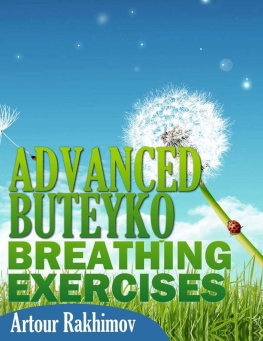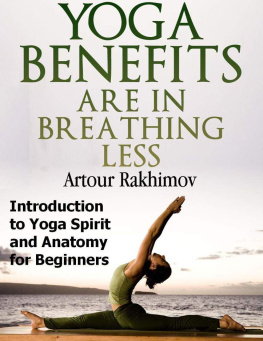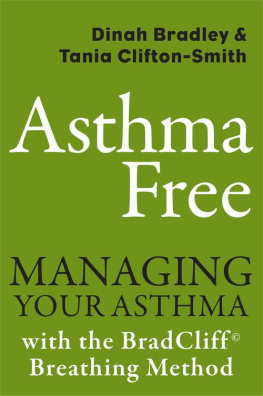Breathing Slower and Less: The Greatest Health Discovery Ever
Artour Rakhimov, PhD
Illustrations by Victor Lunn-Rockliffe
Acknowledgments
Let me express my gratitude to all people whose help made the existence of this book possible. In particular, sincere thanks to artist Victor Lunn-Rockliffe (UK) for his beautiful illustrations and to Anne Burns and Mark Callan (Ireland), Steve Green and Carolina Gane (the Netherlands), Ian Pate, Paul Diffley and Duncan Robertson (UK) for proofreading and/or valuable remarks which improved the quality of the manuscript.
I extend my deepest gratitude and heartfelt thanks to my breathing teachers Ludmila Buteyko and Dr. Andrey Novozhilov, MD (both from the Moscow Buteyko Clinic, Russia), and to Victor Lunn- Rockliffe (Great Britain), Dirk van Ginneken (Dutch Buteyko Institute), medical nurse and Glasgow University Lecturer Jill McGowan (Glasgow, Scotland; BIBH), Charles Maguire (Ireland), Peter Kolb (Australia) and many other breathing practitioners and teachers for spiritual support and lively discussions.
Artour Rakhimov 2007-2014
It is prohibited to copy, lend, adapt, electronically transmit, or transmit by any other means or methods without prior written approval from the author. However, the book may be borrowed by family members.
Disclaimer
The content provided herein is for information purposes only and not intended to diagnose, treat, cure or prevent cystic fibrosis or any other chronic disease. Always consult your doctor or health care provider before making any medical decisions). The information herein is the sole opinion of Dr. Artour Rakhimov and does not constitute medical advice. These statements have not been evaluated by Ontario Ministry of Health. Although every effort has been made to ensure the accuracy of the information herein, Dr. Artour Rakhimov accepts no responsibility or liability and makes no claims, promises, or guarantees about the accuracy, completeness, or adequacy of the information provided herein and expressly disclaims any liability for errors and omissions herein.
Introduction
The most successful clinical trial in the whole history of cancer research was conducted using the Buteyko method. Dr. Sergey Paschenko, MD, a pupil of Dr. Buteyko, published the results of this trial on 120 people with metastatic cancer (early metastasis) in Ukrainian Oncology Journal. The group that practiced reduced breathing exercises had 6 times less mortality in 3 years in comparison with the control group.
Here is another fact: 6 most effective Western clinical trials on asthma were conducted using the Buteyko method. What is common for cancer and asthma? Symptoms and development of these health problems correlates with O2 levels in body cells.
We need more oxygen in body cells to prevent and fight over 150 most popular modern diseases! Yes, modern diseases are virtually always accompanied by low tissue oxygenation. The conditions are ranging from heart disease and cancer, the main killers in the west, to hormonal and digestive problems, diabetes, and asthma.
Tissue hypoxia (low oxygenation of cells) is usually a global phenomenon. No oxygen in one organ or part of the organism usually means that all other vital body organs have inadequate oxygen supply as well. Among them are the brain, heart, kidneys, liver, pancreas, spleen, stomach, both intestines, and hormone producing organs.
Solutions? Oxygen transport depends on many factors, including:
- what and how we eat,
- the way we sleep (sleeping positions),
- posture,
- emotions and stress,
- thermoregulation,
- physical exercise,
- and, of course, the way we breathe.
Should we try to breathe bigger and deeper? Consider the following medical and physiological facts: 1. Take 100 deep and fast breaths through the mouth and you can pass out due to lack of oxygen and blood supply for the brain.
2. Forceful hyperventilation for 15-20 min caused deaths in all dogs and horses due to tissue hypoxia and cardiac failure (heart attack).
3. More breathing means less oxygen and blood for all vital organs (brain, heart, GI organs, liver, lungs, etc.)
4. Sick people (asthma, heart disease, cancer, insomnia, fatigue, etc.) breathe 2-4 times more air per minute than the medical norm.
5. The sicker they are, the faster and deeper they breathe and the shorter their breath holding time (index of oxygenation).
These clinical observations were made by a leading Soviet physilogist Dr. Konstantin Buteyko, MD,PhD. Let us consider these effects, their causes, and clinical evidence in more detail.
Chapter 1. CP (control pause): your oxygenation index
1. 1 You can easily measure your body oxygenation
Breath holding time is an accurate and sensitive measure of tissue oxygenation.
How can we measure breath holding time? We can measure it after exhalation, or after full inhalation, or after 3 or 5 big deep breaths. The test can also be done while sitting or standing. We can also either push the number to its maximum values (hold your breath as much as possible) or stop it at the first signs of air hunger. Out of all these variations, which test is the best representation of oxygenation? Breath holding time after a usual inhalation is greater than after exhalation. The test can also be done after big inhalation. However, one person may have very strong breathing muscles and large capacity of the lungs, another person not.
Hence, parameters of the lungs would affect the results in these cases. What about simple relaxation of the whole body? Such relaxation produces natural spontaneous exhalation. The end of this natural (not forceful!) exhalation is the best time to start the test.
Is it necessary to pinch the nose? Practice shows that, even with our best intentions, we still breathe through the nose when we try to stop breathing but the nose is not pinched. The air exchange is only 5-15% usual breathing, but the results would be less accurate. Hence, we need to pinch the nose (and close the mouth!).
Holding breath for as much as possible is dangerous for many people, for example, due to dramatic increase in blood pressure. Other people can later suffer from panic attacks or migraine headaches due to long breath holds. It would make sense then to stick with a stress-free test, which is done until the first desire to breathe. Practice shows that this first desire appears together with the involuntary push of the diaphragm or swallowing movement in the throat.
(Your body warns you, Enough!). If you stop the test and resume breathing at this moment, you will be able to breathe usually or as before the test. No stress, an easy comfortable test.
Look at the diagram below: after the test you can comfortably breathe as before the test.
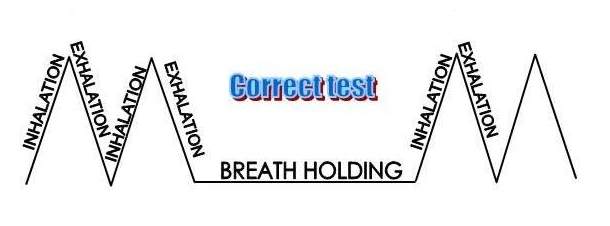
If you hold the breath for too long time, the first inhale will be deep and noisy, as here:
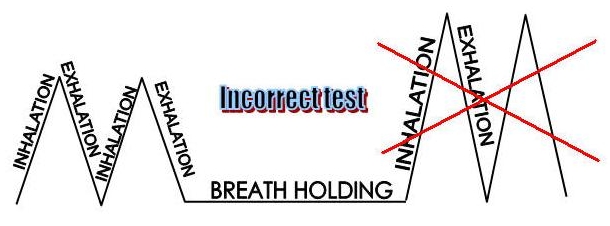
Measurement of the CP (control pause)
Sit down and rest for 5-7 minutes. Completely relax all your muscles, including the breathing muscles. This relaxation produces natural spontaneous exhalation (breathing out). Pinch your nose at the end of this exhalation and count your CP (breath holding time) in seconds. Keep the nose pinched until you experience the first desire to breathe, so that, after you release the fingers, you can resume your usual breathing (in the same way as you were breathing just before you started to hold your breath). Do not extend breath holding too far.
Next page

